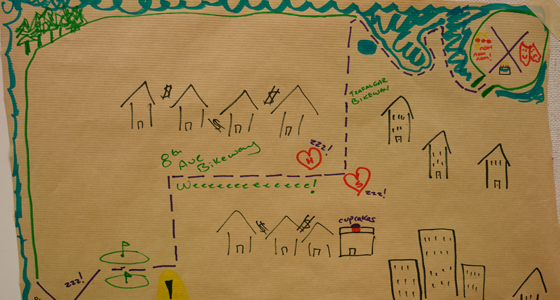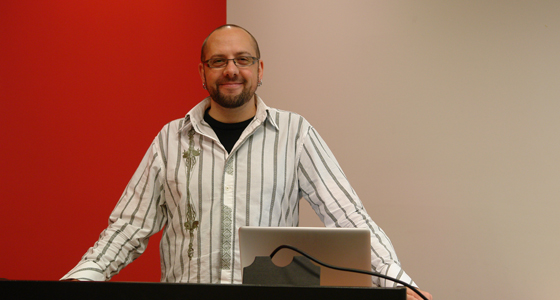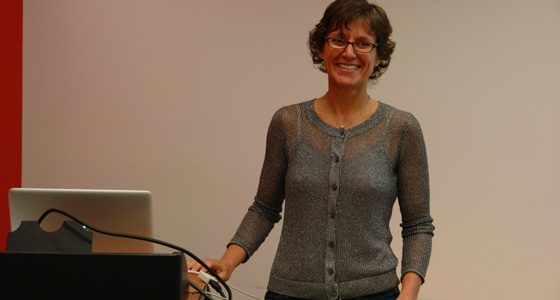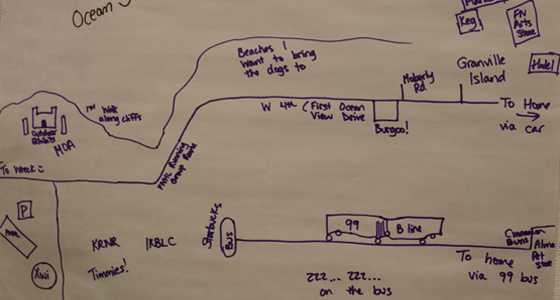 At the workshop Bridging the Knowledge Gap: Indigenous Foundations, Dr. Lisa Nathan and Dr. Daniel Heath Justice incorporated experiential knowledge, insightful group dialogue, and an eclectic mix of activities to deepen the understanding of how to create meaningful discussions on Indigenous topics. The workshop, part of the event series Classroom Climate: Aboriginal Initiatives, guided participants in finding a way for diverse audiences to engage with Aboriginal issues, as well as evoke critical reflection from students within the framework of a course.
At the workshop Bridging the Knowledge Gap: Indigenous Foundations, Dr. Lisa Nathan and Dr. Daniel Heath Justice incorporated experiential knowledge, insightful group dialogue, and an eclectic mix of activities to deepen the understanding of how to create meaningful discussions on Indigenous topics. The workshop, part of the event series Classroom Climate: Aboriginal Initiatives, guided participants in finding a way for diverse audiences to engage with Aboriginal issues, as well as evoke critical reflection from students within the framework of a course.
 The workshop began with a short story, called Butterflies by Patricia Grace, which participants were asked to read. The story was used to open a discussion about cultural collision and finding a way to talk as humans, rather than adversaries, in order to engage in more deep-rooted, provocative questions. In the story, a young girl living with her grandparents gets ready to attend school, a point of pride for her grandparents who boast about it to their neighbour. When the girl returns from school she tells her grandparents, who are harvesting cabbages and beans on their farm, the story about butterflies that she wrote in class. “‘I killed all the butterflies,’ she read. ‘This is me and this is all the butterflies.’” When asked if her teacher liked what she wrote the girl tells her grandparents what the teacher said: “butterflies are beautiful creatures. You don’t kill butterflies.” After a moment the grandfather replies with what accurately summarizes the message of the story. He says: “[b]ecause you see, your teacher, she buy all her cabbages from the supermarket and that’s why.” Tucked between the grandparents’ pride in the little girl’s ability to get an education is an unawareness of the miscommunication going on at school. Killing certain butterflies is a necessity for the grandparents who are trying to successfully grow their own crops, but in the setting of where the school is, it is seen as a heinous act because of the romanticized image that butterflies hold. The short story is not an attack on tradition, but rather shows the result of the meeting of cultures, and asks the question “what is our experience together?”
The workshop began with a short story, called Butterflies by Patricia Grace, which participants were asked to read. The story was used to open a discussion about cultural collision and finding a way to talk as humans, rather than adversaries, in order to engage in more deep-rooted, provocative questions. In the story, a young girl living with her grandparents gets ready to attend school, a point of pride for her grandparents who boast about it to their neighbour. When the girl returns from school she tells her grandparents, who are harvesting cabbages and beans on their farm, the story about butterflies that she wrote in class. “‘I killed all the butterflies,’ she read. ‘This is me and this is all the butterflies.’” When asked if her teacher liked what she wrote the girl tells her grandparents what the teacher said: “butterflies are beautiful creatures. You don’t kill butterflies.” After a moment the grandfather replies with what accurately summarizes the message of the story. He says: “[b]ecause you see, your teacher, she buy all her cabbages from the supermarket and that’s why.” Tucked between the grandparents’ pride in the little girl’s ability to get an education is an unawareness of the miscommunication going on at school. Killing certain butterflies is a necessity for the grandparents who are trying to successfully grow their own crops, but in the setting of where the school is, it is seen as a heinous act because of the romanticized image that butterflies hold. The short story is not an attack on tradition, but rather shows the result of the meeting of cultures, and asks the question “what is our experience together?”
 After the story, and a discussion about the challenges of accurately recognizing Indigenous topics in the classroom, Dr. Lisa Nathan, Assistant Professor at UBC’s School of Library, Archival and Information Studies (SLAIS), and Coordinator for the School’s First Nations Curriculum Concentration, introduced the Indigenous Foundations website. Developed by the First Nations Studies Program, the site was created in response to the lack of participation in conversations on Indigenous-oriented topics, which happens when people are afraid of saying the wrong things. Indigenous Foundations works as an information resource for students, instructors, researchers, and the general public on topics relating to histories, politics, and cultures of the Aboriginal peoples of Canada. Dr. Nathan noted that the intention of the website is to provide information that is represented in a way in which people can literally see the relationships between various topics. Furthermore, the site is meant to offer basic foundational knowledge for people to begin their inquiry into Aboriginal and settler histories and futures. “The modular resources from the site can be selected to meet the needs of particular teaching environments,” Dr. Nathan added.
After the story, and a discussion about the challenges of accurately recognizing Indigenous topics in the classroom, Dr. Lisa Nathan, Assistant Professor at UBC’s School of Library, Archival and Information Studies (SLAIS), and Coordinator for the School’s First Nations Curriculum Concentration, introduced the Indigenous Foundations website. Developed by the First Nations Studies Program, the site was created in response to the lack of participation in conversations on Indigenous-oriented topics, which happens when people are afraid of saying the wrong things. Indigenous Foundations works as an information resource for students, instructors, researchers, and the general public on topics relating to histories, politics, and cultures of the Aboriginal peoples of Canada. Dr. Nathan noted that the intention of the website is to provide information that is represented in a way in which people can literally see the relationships between various topics. Furthermore, the site is meant to offer basic foundational knowledge for people to begin their inquiry into Aboriginal and settler histories and futures. “The modular resources from the site can be selected to meet the needs of particular teaching environments,” Dr. Nathan added.
Within the Indigenous Foundations website, a mapping tool of the Kitsilano Indian Reserve shows key points of land development between 1869 and 2002, and is intended to reveal the role of human interaction in the development of space, namely the city of Vancouver. “It’s not the product of inevitability. These things happen over time because people made choices. It was never a natural process,” said Dr. Daniel Heath Justice, Chair of the First Nations Studies Program and an Associate Professor at UBC. The interactive site underscores an essential fact: we are not studying the past. Dr. Justice, who also holds a joint position with UBC’s Department of English, said students often come into his classes thinking that the Aboriginal issues being discussed are simply problems in the past, and that the solution is to find a way to move on. However, Dr. Justice asserts that “[the problems] are embedded in privilege and power relationships, and understanding is really about empathy, not blame. History may affect the conversations you have with people around that space because the history of a place and the history of a person are intertwined; integrating place into personal history.”
 As a hands-on way to demonstrate the relationship between history and place, the participants were asked to draw a map of what their journey from UBC campus to Granville Island would look like. They were asked to include all the places that have personal meaning to them, and encouraged to interpret the word “map” as creatively as they pleased. This resulted in a colourful representation of personal histories and stories of the land. More varied than the artistic abilities were the important points of interest, and the ways in which they were highlighted, on each of the maps. For Dr. Justice, his map was “not about the places, so much as the people along the route and the locations where we already have so many memories.”
As a hands-on way to demonstrate the relationship between history and place, the participants were asked to draw a map of what their journey from UBC campus to Granville Island would look like. They were asked to include all the places that have personal meaning to them, and encouraged to interpret the word “map” as creatively as they pleased. This resulted in a colourful representation of personal histories and stories of the land. More varied than the artistic abilities were the important points of interest, and the ways in which they were highlighted, on each of the maps. For Dr. Justice, his map was “not about the places, so much as the people along the route and the locations where we already have so many memories.”
Addressing the broader workshop topic of “bridging the knowledge gap,” Dr. Justice suggested that when it comes to engaging in conversations about Aboriginal topics, one needs to become “more comfortable with being uncomfortable.” Creating an open environment and having a strategy in the classroom also helps to explore the nuanced and complicated natures of the issues. Dr. Justice, as a citizen of the Cherokee Nation, acknowledged one last question: do I have the right to talk about this? Does a non-Indigenous person have the right to speak about these issues? What he believes is that “you don’t just have the right to do it, you have the responsibility. The trick, though, is finding a way to approach the responsibility correctly.”
[…] issues, Dr. Daniel Heath Justice and Dr. Lisa Nathan led a highly engaging session called Bridging the Knowledge Gap: Indigenous Foundations. During this interactive workshop, they guided participants through creative teaching activities, […]